Caragana feed
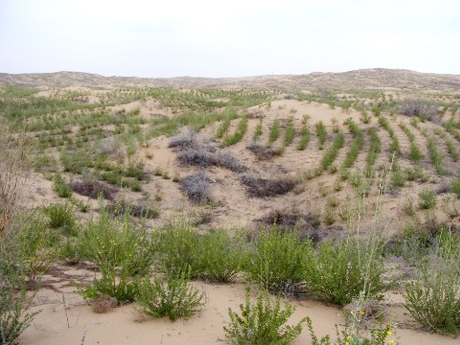
Caragana plantation in a sand dune in Ningxia, China (planted in spring 2012, photographed in July 2015)
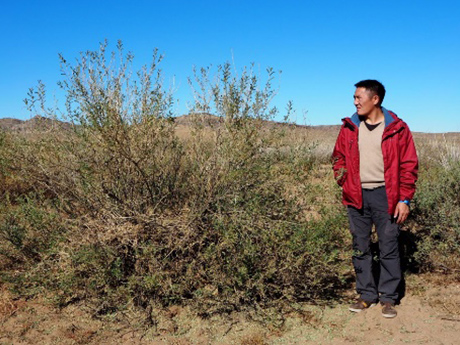
Caraganagrowing naturally in Bulgan Province in Mongolia
Source plants
- scientific name
- Caragana spp.
- general name
- Genus Caragana, caragana, ning tiao (China), hargana (Mongolia)
Caragana sinica (Buc’hoz) Rehder: Caragana sinica, Chinese peashrub, jin que gen Caragana korshinskii Kom: Caragana korshinskii, ning tiao Caragana arborescens Lam.: Caragana arborescens, Siberian peashrub, Caragana
- overview
-
Genus Caragana (hereinafter, caragana), which contains about 80-100 species, belongs to the family Fabaceae. It naturally grows in temperate to subarctic areas in Asia and South Eastern Europe. It is a deciduous shrub or small tree which is 1-6 m in height, with pinnate compound leaves in even numbers and small leaflets. It forms single gregarious papillionaceous flowers in yellow (sometimes in white or pink) in axils and bears seeds in linear pods, which become feed for larvae of the order Lepidoptera such as Acronicta tridens in the family Noctuidae.
Caragana is highly drought- resistant and can grow on infertile land as it fixes nitrogen. Therefore it is an important plantation tree for re-vegetation in areas with advanced desertification especially in Central Asia. It is sometimes said that the dominance of caragana increases in grassland in this area along with the progress of desertification, but overgrazing causes difficulty maintaining the caragana community as grazing sheep and goats eat the plant intensively in winter. Recently in China, technological development of artificial feed from caragana has progressed, and it is expected that promotion of re-vegetation by planting, stabilization of cattle breeding through supplying artificial feed, and reduction of grazing pressure on natural vegetation will become compatible.
The roots of Caragana sinica contain many active pharmaceutical ingredients such as saponin, stilbene derivatives, and caraganosides. They are used for treatment of arthritis, diarrhea, and bone fragility in South Korea. Also, saccharomyces (fermented caragana root extract) is an extract obtained from caragana roots by fermenting them as a substrate with saccharomyces yeast, and it is used in products such as body care essence, skin toner, and soaps as an antioxidant. Olennikov and others extracted 16 components from flowering branches of Caragana bungei Lede produced in Russia, and separated Phenylpropanoids and gallic acid from plants in the family Caragana for the first time (2012).
Product characteristics
- use
- Afforestation tree, ornamental plant, livestock feed, ingredients for cosmetics
- area
- orthern China, Mongolia, Russia, India, Nepal, Pakistan, South East Europe
- overview
-
Commercialization of caragana artificial feed in China
The initiative of commercialization of caragana artificial feed in China started in the late 1990s in Ningxia Hui Autonomous Region on the southern edge of Inner Mongolia. Production started in the early 2000s and it has now been developed as a new industry, albeit small, in areas within the autonomous region, where caragana grows well.
One of the reasons behind making caragana artificial feed is that a grazing ban policy was implemented on a full scale in the late 1990s and demand of feed for herbivorous livestock, which mainly includes sheep, cows, and goats increased. In addition, an effective management method for caragana is to regularly cut it down and coppice as it starts to weaken in ten-odd years (in several years for specific species) in many cases, and was used for the caragana shrubland that was created as a result of the afforestation project that the government had promoted from the early 1970s, about 30 years earlier.
One of the nutritional value characteristics of caragana feed is, according to an analysis using Caragana intermedia, that it produces a long-lasting feeling of satiety for livestock as it obviously contains a larger amount of crude fiber, although crude protein and fat are close to the average value of general hay feed. Caragana contains a higher percentage of woody components compared to general grass and there was concern about palatability, however, according to the palatability test carried out on sheep by Ningxia Hui Autonomous Region Agriculture and Forestry Academy, it was found out that sheep, goats, and cows can easily eat it if it is crushed into granules 1 to 3 mm in diameter or threads and that feed intake is increased by 13.1% compared to silage of corn stems and leaves, and moreover, cows like pellet feed of caragana the best.
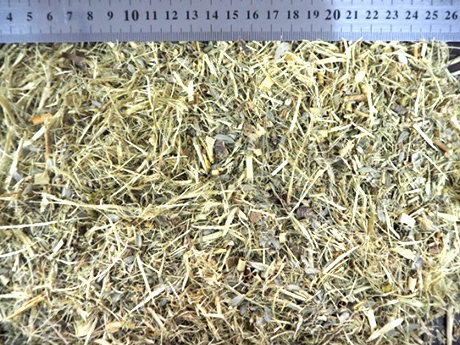
Caragana grass feed

Pellet feed
Sustainable harvest by coppicing
For regeneration by coppicing in harvested shrub stands, the biomass quantity becomes 80% or more of that before harvesting in three years and 100% or more in four years. The nutritive value as feed is at its best if harvested at the third year. It is safe to harvest from newly planted caragana in or after its fifth year. Cutting no more than 5 cm from the ground is best for work efficiency and the growth of sprouts.
Harvesting in caragana shrubland is carried out three or four times per shrub stand in order to maximize the environmental preservation effects such as the wind shield effect. The plants should preferably be cut down in strips with a width of around 10 m. This is to protect coppiced plants from wind as the wind shield effect range of shrubbery with caragana of 1-1.5 m in height is about 10 m.
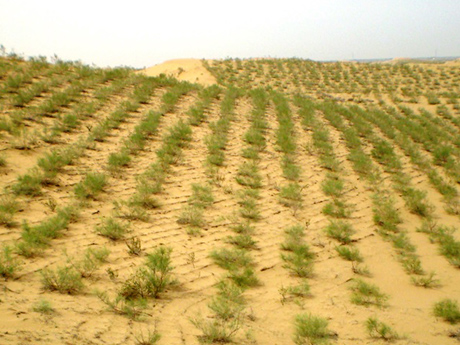
Caragana planation (two years old)

Caragana planation (three years old)
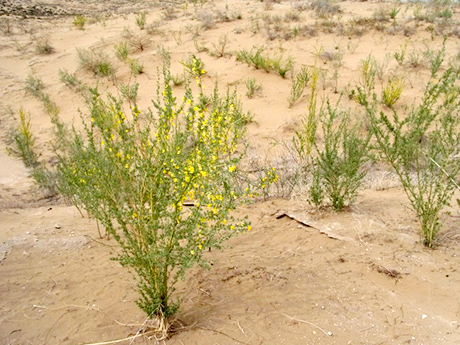
Individual caragana (three years old)

Coppiced caragana (four years old)
Caragana feed, processing and production plant
The method of caragana harvesting depends on the terrain of the woodland, but it is done by automatic harvesters in places where tractors can move. In areas where it is difficult for machinery to move around, backpack brush cutters are used. In China, many types of self-propelled or traction type harvesting machines for shrubs including caragana have been developed. There is large machinery where reaping, packing, compressing, and transport functions are integrated, and self-propelled machines only for reaping. It is possible to choose from them depending on natural conditions and the scale of business.
The feed processing method is simple: break harvested whole caragana into pieces, and compress them into pellets as necessary. A grinding machine is indispensable. In China, conventional grinding machines for stems and leaves are remodeled to be more powerful and used for small-scale production by individual farmers with production amounts of 1.5-2 tons of grass feed per day. In the case of factory production, processes such as grinding, pellet production, packaging are automated, and there are few problems in mechanical production ability as long as ingredients keep being supplied.
Consideration of caragana artificial feed project in Mongolia
In Mongolia, where the number of livelihood increased rapidly due to the shift to the market economy, desertification due to grazing pressure on grassland has advanced across the country, causing a vicious cycle of further shortage of feed. It is urgently necessary to produce artificial feed domestically and expand its use. For this reason, a livestock feed production business model through caragana plantations was examined with reference to the already commercialized artificial feed production of caragana in Ningxia, China. In Mongolia, caragana grows naturally and widely. However, based on the factors that sheep and goats eat it intensively in winter and that the decrease of caragana, which has a function for desertification prevention, is feared, afforestation with caragana is assumed. With the low availability of grazing land, the target area is set to be around the Gobi Desert, where the Mongolian government recommends afforestation, and considering the costs such as capital investment and employment cost at a little lower price than that of imported feed, it was estimated that 1,500 tons or more of trees for raw material are needed annually to be profitable. Based on this estimation, for example, a business model where it is possible to recover investment from the seventh year can be expected by afforesting caragana under the following conditions: harvesting amount to be 3.5 tons/ha at the third year, regeneration by coppicing, period of three years, and an area of 1,500 ha (500 ha/year). Caragana feed is higher in nutritive value than wheat bran, which is the common feed in Mongolia. It can be a feed for race horses by making it into pellets, so it is conceivable that investment from the race horse industry such as horse owners can be expected.
- references
-
- https://en.wikipedia.org/wiki/Caragana
- http://www.pfaf.org/user/Plant.aspx?LatinName=Caragana+sinica
- Olennikov, D.N., L.M. Tankhaeva,V.V. Partilkhaev, A.V. Rokhin (2012) Chemical constituents of Caragana bungei shoots. Brazilian Journal of Pharmacognosy 22: 490-496
- Suttie, J.M., S.G. Reynold, C. Batello (2005) Grassland of the world. 514pp, FAO
- FAO (2010) Global Forest Resource Assessment 2010. Country Report: MONGOLIA. 51pp.
- Narantsetseg, A., S. Kang, B.E. Lkhamsuren, D.W. Ko (2014) Determinants of Caragana microphylla density distribution in the Mongolian steppe. Ecol. Res. DOI 10.1007/s11284-014-1173-y
- Jiang, D., C. Cao, Y. Zhang, Z. Cui, X Han (2014) Plantations of native shrub species restore soil microbial diversity in the Horqin Sandy Land, northeastern China. J. Arid Land 6: 445-453
- Alamusa, D. Jiang (2014) Characteristics of soil water consumption of typical shrubs (Caragana microphylla) and trees (Pinus sylvestris) in the Horqin Sandy Land area, China. Frontiers of Forestry in China 4: 330-337
- Sergelenkhuu, J., U.G. Nachinshonhor, T. Otoda, Y. Yamada, J. Undarmaa, K. Sakamoto, K. Yoshikawa (2012) Effect of grazing pressure on the structure of rangeland plant community in Mongolia. Journal of Arid Land Studies 22: 235-238
- 賽西雅拉図・酒井啓・小泉武栄(2007)中国・内モンゴルのアバガーホシュー草原における飼育家畜の密度と草原荒廃の関係. 東京学芸大学紀要.人文社会学系.Ⅱ, 58: 21-35
- 藤森末彦(2007)中国・黄土高原の植林技術.熱帯林業69号, 48-56
- 林野庁(2013)CDM植林総合推進対策事業(途上国の情報収集・整備)報告書.179pp
- 社団法人海外林業コンサルタント(2008) 砂漠化を防ぎ黄砂の発生を抑える植林技術31pp.
- 小長谷有紀(2007)モンゴル牧畜システムの特徴と変容. E-journal GEO 2: 34-42


